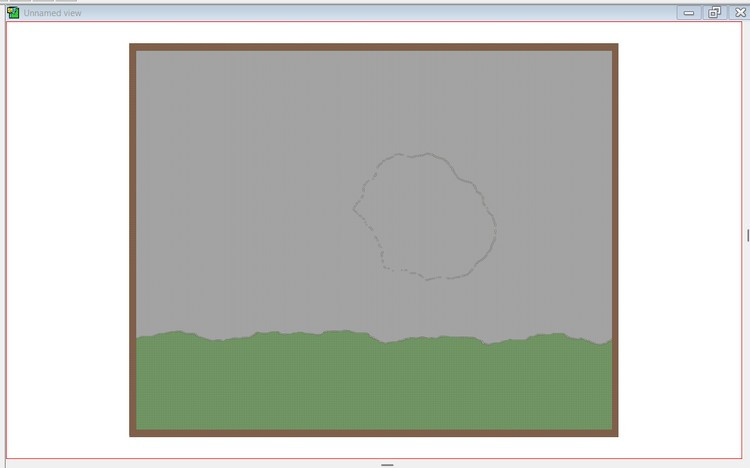
Wyvern
Wyvern
About
- Username
- Wyvern
- Joined
- Visits
- 3,125
- Last Active
- Roles
- Member
- Points
- 5,360
- Rank
- Cartographer
- Badges
- 24
-
Live Mapping: Fantasy Hand-drawn Part 2
-
Dungeon Level Symbols
On the beds subject, I spent part of today constructing a plausible top-down, dungeon-scale view of a four-poster bed, with curtains. Essentially, it's a cutaway, because the top's missing, given seeing where the bed (and anything hidden by the drawn curtains) is more important than that top cover panel (which could be added using a rug/carpet, if available, anyway - or even a repurposed and maybe resized wooden table).
What surprised me a little is there aren't any such beds in the styles I was using (DD3 Dungeons Digital and SS2 Fantasy, so all vector designs); generally, the vector styles have a lot more variety in their symbol options, probably because vector is an easier style to work with/draw in overall, of course. Which at least meant it wasn't that hard to take a suitable bed, and resize different varicolor pieces to work as posts and their feet, with wall-symbol curtains, to create such a bed.
For raster symbols though, it would be great to have some actual options that don't need extra user input!
-
[WIP] Applevale
Something you might consider is using this kind of pictorial drawing to illustrate a more traditional top-down map of the same (or a larger) area, in a loose medieval style. Pauline Baynes used this concept to splendid effect on her Middle Earth maps for J R R Tolkien, and her Narnia maps for C S Lewis, for instance, showing images of selected, specific places on the maps.
-
[WIP] Applevale
Exactly!
I don't think it really matters what kind of top-down style you choose - even if the settlements are just dots, the pictorial representation shows what's actually there, which is really the point in many respects. The actual region map would really be too small to show pictures of the settlements to scale, so the drawing shows those at the expense of "unrealistic" scenery and scaling instead.
Many of the pictorial styles we routinely use in CC3+ are already a compromise between accurate images and true scaling anyway. Ricko's shown masterfully and repeatedly what can be achieved by ignoring scaling entirely, and going for a purely pictorial representations using those images!
-
[WIP] Rise of the Crone-Mother
You don't need to invoke hag magic for the warmth. Think Neverwinter in the Forgotten Realms, which is in a not dissimilar northern location - subterranean volcanic heat can help here too. And/Or you could have the seas warmed by the volcanic offshore island on the regional map's edge, with likely more undersea volcanism nearby as well. Warmer seas in a colder climate will give plenty of surface fogs and mists, so all nicely humid, dank and dark (fogs often lift into very low clouds that artificially darken the days, for instance), so also ideal hag territory!
-
[WIP] Rise of the Crone-Mother
And, because this is the most recent of your topics to be updated here RS, a quick "well done" on having a second Cartographer's Annual showcasing your maps this year, with this month's issue just out!
-
My CC3+ journey ..
This seems highly apt, given the long and difficult journey that has only very recently started to give us the physical world of Dolmenwood out in this reality! Indeed, when I saw your first post here, I thought that was where you were going with this topic 😊.
[Dolmenwood's a highly-detailed RPG and world-setting, published by Necrotic Gnome, as I know we're not all RPGers here. It's very dependent upon magical dolmens, standing stones, magical ley-lines and such like. And of course, it also has grimalkins, fey-cat-folk, as player-characters (amongst many other things)!]
-
When making wall on dungeon it does'nt work properly.
Or try what I did, and which Sue beat me to posting about (😁), which was simply to change the properties of that piece of floor to be the same as the wall you'd already drawn:
There's always more than one way to do something using CC3+; you just have to hunt around to find it sometimes!
-
How Can I Draw Real-World Places in Campaign Cartographer?
- The style choice is obviously up to you, but the original PDF map you shared uses only very simple textures and plain colours for the hexes, and that wouldn't need more than a couple of texture bitmap fill options to accomplish, which the standard CC3+ overland styles could likely provide.
- Once you have your source map as a bitmap image (a simple JPG will be fine), all you need then do is create a new Sheet in your CC3+ drawing, for ease call it "BITMAP", and a new Layer, also "BITMAP", and make sure both layers are active (click in their respective check-boxes, if necessary). Then, using the drop-down menu Draw => Insert file simply navigate to where your source map's image is stored, and click "Open". You'll then be asked to click the "First corner" (in the CC3+ window's command line), so pick a suitable spot in your map, and then enlarge the image to an appropriate size, before clicking to locate the "Second corner". Your map image will then be set-up in your CC3+ map file. Once the image is in-place, you can move, rescale and adjust it by clicking somewhere on the edge of the image (only), when the Command line asks you to "Select entities" for whatever command you want to carry out. You will need to check the map scale is correct once your image is in-place, by using the Info => Distance drop-down menu command to measure between two points on the image whose separation you know (flat to flat of a hex, for example), for simplicity making sure "Snap" is turned off, but "Ortho" is on. If the map image is too large or small for the hex-sizes you want, you can rescale it either by-hand, or (better) numerically, by typing the values into the Command line when prompted (and you can just ask it to multiply or divide with the numerical sizes; you don't need to work that out separately).*
- Not sure why the hex snap grid isn't working for you, assuming you're trying to duplicate the map whose image you showed, because the terrain is shown as per whole hex there, so it'd be easier for you to just work with drawn hex-shaped polygons (created using the hex-corner points in the snap grid), and then place those hexes where required. As long as the hexes are the correct size for what your final map needs to show, this should be fine, and work with the snap grid.
- Curves can be tricky, but you can simply draw lines using the straight path (or polygon) option instead. You'll need to click to add more nodes for lines/polygon edges to still seem curved in places, but it avoids the oddness that using the curved drawing tools can create sometimes.
- You may have the arrow cursor set instead of the crosshairs one (crosshairs show exactly where your cursor is using a crosshair that covers the whole map). To change from one to the other, simply press Ctrl + T (and see this post for another option, as well as a caveat on this command's use).
Without seeing exactly what you're trying to draw, I suspect it'll be hard to give more concrete advice than this, but hopefully this will get you a bit further forward.
* [EDIT: I should also note that when you start to import your map image, you'll be asked what file path to use for the source map's image. For ease, it's preferable to have that source map image in the same folder on your computer as the CC3+ map file, and simply keep the "Store the file's path relative to the current drawing" radio button active - it's the default option for this query panel.]
-
What are you using your maps for?
Thanks very much folks!
@Mike: Weirdly, the Ireland maps are the only ones I showed that have never been published! The main Erin one is still one of my favourites, partly because it was done so early in my CC mapping and yet turned out so well, partly because of all the interesting things I was able to find while researching it.
@Sue: I rather envy people who can just sit down and create a map from scratch, or have an idea in their head they can bring to life as they go. I have to plan in detail in advance!
@OverCriticalHit: All these maps were done using CC3, not CC3+, and so far as I recall, there wasn't any other option beyond tracing the coastlines in by hand using that. There are options now that would let you automatically trace a sufficiently contrasting edge within an imported image, for instance, and that would have helped to a degree.
One big problem I had was that with the Near East and Black Sea maps, the areas covered weren't available on any single atlas or paper maps I could source, where there was a consistent scaling and use of contours. The problem was so great for the Near East ones, I eventually abandoned attempts to draw them as contour maps, and opted for the simpler Mercator-style drawings instead. Even on the Black Sea map, I simply had to wing-it to fill gaps towards the eastern edge on the maps I had.
Of course, things get still more complicated when you're trying to adjust coastlines to their ancient appearance using what may be a simple line-drawing map in a published research paper, a sketch-map that may not be even in the same projection as that in the atlas chosen as a potential base map, let alone have a similar scale, or show any contours or other connecting features!
I suspect that because I've been drawing maps for a very long time, at first only by hand, then later using various DTP or graphics programs, the idea of hand-drawing suitable polygons, both of the coasts and the contours, which may each sometimes take a number of sessions scattered over several days, hand-tracing something like these isn't such a big thing in CC. Indeed, there may be advantages to this, as several problems appearing on the Forum in recent times have resulted from traced coastlines having too many fractal nodes along them, and crashing the program as a result. Approaching mapping from the direction I have, means that for many years, I've tended to draw things like coastlines using only straight-edge polygons, since at this kind of regional scale, you can't tell any difference. If you need a curve, you just add a few more nodes. So if you look at the Black Sea map, for all the seeming complexity of the coasts there (many of the contours were done using smooth polygons instead), I didn't have a single CC3 crash while drawing it this way. I did foul up a couple of times, and have a lot of redrawing to do as a result (there may have been Naughty Words said as well...), but that was down to me, not the program!





